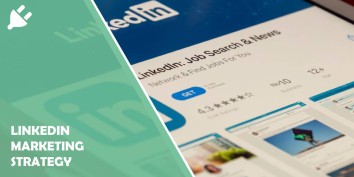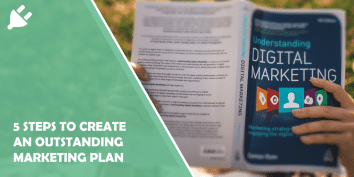Small businesses can not afford to let go of social media platforms because all these…
The mobile app market has been growing rapidly in recent years, with millions of apps available on various app stores. In this competitive landscape, it’s essential to have a well-thought-out mobile app marketing strategy to ensure that your app stands out and attracts users. Here are eight steps to consider when developing your mobile app marketing strategy.

Step 1: Identify Your Target Audience
The first step in developing your mobile app marketing strategy is to identify your target audience. Who are the people that your app is designed for? What are their interests, demographics, and behaviors? Once you have a clear understanding of your target audience, you can tailor your marketing efforts to reach them effectively.
There are several ways to identify your target audience, such as conducting market research, analyzing customer data, or creating user personas. User personas are fictional characters that represent your ideal users and provide insights into their motivations, preferences, and pain points.
Step 2: Define Your Unique Value Proposition
Your unique value proposition (UVP) is a statement that communicates the unique benefits of your app to your target audience. It should describe how your app solves a problem or fulfills a need that other apps don’t. A strong UVP can help you differentiate your app from the competition and attract users who are looking for a solution to a specific problem.
To define your UVP, you should conduct a competitive analysis to identify the strengths and weaknesses of your competitors. Look for gaps in the market that your app can fill and highlight the features and benefits that set your app apart.
Step 3: Optimize Your App Store Listing
Your app store listing is the first point of contact between your app and potential users. It’s crucial to optimize your listing to ensure that it’s attractive, informative, and persuasive. Your app store listing should include the following elements:
- App name and icon: Choose a name and icon that are memorable, distinctive, and reflective of your brand and app’s purpose.
- App description: Write a compelling description that highlights your app’s unique features, benefits, and UVP. Use keywords that your target audience is likely to search for and keep the language simple and easy to understand.
- Screenshots and videos: Include screenshots and videos that showcase your app’s interface, functionality, and user experience. Use high-quality visuals that are easy to understand and align with your brand.
- Ratings and reviews: Encourage users to rate and review your app to build social proof and credibility.
Step 4: Leverage Social Media
Social media is a powerful tool for promoting your app, building your brand, and engaging with your target audience. You can use social media to:
- Create a social media page for your app and share updates, news, and content related to your app.
- Run paid social media campaigns to reach a broader audience and drive app installs.
- Partner with influencers and bloggers to reach their followers and generate buzz around your app.
- Use social media analytics to track your performance and optimize your strategy.

Step 5: Implement App Store Optimization (ASO)
App Store Optimization (ASO) is the process of optimizing your app store listing to increase your app’s visibility and rank higher in search results. ASO involves several factors, including:
- App title and description
- App icon and screenshots
- App ratings and reviews
- App localization
- App category and keywords
By optimizing these factors, you can improve your app’s discoverability and attract more organic traffic to your app store listing.
Step 6: Implement a Referral Program
Referral programs are an effective way to incentivize your existing users to refer their friends and family to your app. You can offer rewards, such as in-app currency or exclusive features You can offer rewards, such as in-app currency or exclusive features, to users who successfully refer new users to your app. Referral programs can help you increase user acquisition and retention while also building a community of loyal users.
To implement a referral program, you can use in-app messaging or push notifications to encourage users to refer their friends and family. You can also use social media or email marketing to promote your referral program to a broader audience.
Step 7: Run Paid Advertising Campaigns
Paid advertising campaigns can help you reach a broader audience and drive app installs quickly. There are several types of paid advertising campaigns you can run, including:
- Search ads: These ads appear at the top of app store search results and target users searching for specific keywords.
- Display ads: These ads appear on other apps or websites and target users based on their interests or behaviors.
- Social media ads: These ads appear on social media platforms, such as Facebook, Instagram, or Twitter, and target users based on their demographics or interests.
When running paid advertising campaigns, it’s crucial to set a clear budget and goals, use high-quality visuals and ad copy, and track your performance regularly to optimize your strategy.
Step 8: Monitor and Optimize Your Strategy
The final step in developing your mobile app marketing strategy is to monitor and optimize your performance continually. By tracking your metrics and KPIs, such as app installs, retention rates, engagement, and revenue, you can identify areas of improvement and adjust your strategy accordingly.
There are several tools and platforms you can use to monitor your performance, such as Google Analytics, Firebase, or App Annie. By regularly analyzing your data and testing different tactics, you can continuously improve your app marketing strategy and ensure that your app stays competitive in the ever-changing app market.
In conclusion, developing a successful mobile app marketing strategy requires careful planning, research, and execution. By following these eight steps, you can create a strategy that effectively reaches your target audience, communicates your unique value proposition, and drives app installs and engagement. Remember to stay adaptable and flexible, as the mobile app market is constantly evolving, and always be willing to adjust your strategy as needed.






